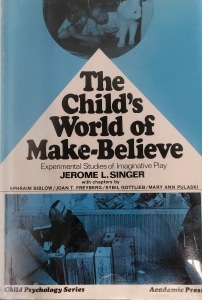 Jerome L. Singer, the distinguished psychologist who explored the depths of daydreaming, and alongside his wife the eminent developmental psychologist Dorothy G. Singer (1927–2016), became a pioneer in the study of imaginative play, died on December 14, 2019. Jerome and Dorothy were charter members of the editorial advisory board of The Strong’s American Journal of Play. With his hundreds of publications over a half century of scholarship, Jerome Singer helped us better understand the mysteries of human consciousness, daydreaming, fantasy, and the child’s world of make-believe.
Jerome L. Singer, the distinguished psychologist who explored the depths of daydreaming, and alongside his wife the eminent developmental psychologist Dorothy G. Singer (1927–2016), became a pioneer in the study of imaginative play, died on December 14, 2019. Jerome and Dorothy were charter members of the editorial advisory board of The Strong’s American Journal of Play. With his hundreds of publications over a half century of scholarship, Jerome Singer helped us better understand the mysteries of human consciousness, daydreaming, fantasy, and the child’s world of make-believe.
Born in New York City on February 6, 1924, Singer earned a bachelor’s degree in psychology from the City University of New York in 1943. He joined the U.S. Army’s 441st Counterintelligence Corps that year, and he served in the Pacific until 1946. After World War II, he studied clinical psychology and earned a PhD from the University of Pennsylvania in 1951. Soon after, he became director of research at Franklin D. Roosevelt Veteran’s Hospital outside New York City. He later pursued private clinical practice in New York City and served as a teaching affiliate at Teachers College Columbia University before becoming the director of the clinical psychology program at City College of New York in 1963. In 1972, he moved to New Haven to direct Yale University’s clinical psychology program. He worked there as a professor, teacher, mentor, and researcher for more than four decades and, together with Dorothy, codirected the Yale University Family Television Research and Consultation Center. In their more than three decades directing the center, the Singers consulted with many of the most influential children’s television programs of the late 20th century, including Mister Rogers’ Neighborhood and Barney & Friends.
 Singer’s groundbreaking 1966 book Daydreaming: An Introduction to the Experimental Study of Inner Experience demonstrated the positive and constructive aspects of a wandering mind while it laid the foundation for the modern study of daydreaming. Singer built on this research in his books The Child’s World of Make-Believe: Experimental Studies of Imaginative Play (1973) and The Inner World of Daydreaming (1975), which examined, among other things, the development of imaginative play and the childhood origins of daydreaming. Singer noted that childhood daydreaming first occurs around age two and evolves out of early make-believe play. Children develop these daydreams, drawing from experiences interacting with and imitating adults as well as the stories read, told, or presented to them in books, movies, and on television. These early daydreams related to play—particularly positive ones focused on happiness and success—can stimulate creativity and problem-solving that allows children to practice life skills, which pays off later as adults. At a time when most people viewed daydreaming as distractions that should be discouraged, Singer demonstrated that these private thoughts were a natural part of children’s and adult’s mental processes.
Singer’s groundbreaking 1966 book Daydreaming: An Introduction to the Experimental Study of Inner Experience demonstrated the positive and constructive aspects of a wandering mind while it laid the foundation for the modern study of daydreaming. Singer built on this research in his books The Child’s World of Make-Believe: Experimental Studies of Imaginative Play (1973) and The Inner World of Daydreaming (1975), which examined, among other things, the development of imaginative play and the childhood origins of daydreaming. Singer noted that childhood daydreaming first occurs around age two and evolves out of early make-believe play. Children develop these daydreams, drawing from experiences interacting with and imitating adults as well as the stories read, told, or presented to them in books, movies, and on television. These early daydreams related to play—particularly positive ones focused on happiness and success—can stimulate creativity and problem-solving that allows children to practice life skills, which pays off later as adults. At a time when most people viewed daydreaming as distractions that should be discouraged, Singer demonstrated that these private thoughts were a natural part of children’s and adult’s mental processes.
 Imagination and make-believe remained at the core of Singer’s work, and together with Dorothy, he published widely on children’s pretend play and the impact of television and media on children’s lives, including in their books Television, Imagination, and Aggression: A Study of Preschoolers (1981); The House of Make-Believe: Children’s Play and the Developing Imagination (1990); Make-Believe: Games and Activities for Imaginative Play: A Book for Parents, Teachers, and the Young Children in Their Lives (2001); Handbook of Children and the Media (2001, 2012); and Imagination and Play in the Electronic Age (2005). In many of these and other studies, the Singers articulated their concerns about the effects of mass media on children’s play as they observed how certain kinds of movies, television, and video games replaced much of children’s creativity in imagining worlds and stories with cultural products. Yet they did not see television or video games as inherently problematic. Indeed, they argued that children’s responses to such media depended on a variety of factors, including the quality of the content, the amount consumed, and whether or not adult caregivers helped children make sense of what they have consumed by discussing it with them. In this way, these forms of media had great potential to be used by educators and caregivers as tools to promote healthy development and behavior.
Imagination and make-believe remained at the core of Singer’s work, and together with Dorothy, he published widely on children’s pretend play and the impact of television and media on children’s lives, including in their books Television, Imagination, and Aggression: A Study of Preschoolers (1981); The House of Make-Believe: Children’s Play and the Developing Imagination (1990); Make-Believe: Games and Activities for Imaginative Play: A Book for Parents, Teachers, and the Young Children in Their Lives (2001); Handbook of Children and the Media (2001, 2012); and Imagination and Play in the Electronic Age (2005). In many of these and other studies, the Singers articulated their concerns about the effects of mass media on children’s play as they observed how certain kinds of movies, television, and video games replaced much of children’s creativity in imagining worlds and stories with cultural products. Yet they did not see television or video games as inherently problematic. Indeed, they argued that children’s responses to such media depended on a variety of factors, including the quality of the content, the amount consumed, and whether or not adult caregivers helped children make sense of what they have consumed by discussing it with them. In this way, these forms of media had great potential to be used by educators and caregivers as tools to promote healthy development and behavior.
Whether exploring daydreaming, fantasy play, or children’s television programming, so much of the Singers’ work focused on the critical importance of imaginative play and its role in cognitive, emotional, social, and physical development. It was ultimately this work and their pioneering contributions to the field of play, as Dorothy noted in a 2012 American Journal of Play interview, that gave them “the most satisfaction.”
 Hours 10 a.m.–5 p.m. | Fri. & Sat. till 8 p.m.
Hours 10 a.m.–5 p.m. | Fri. & Sat. till 8 p.m.